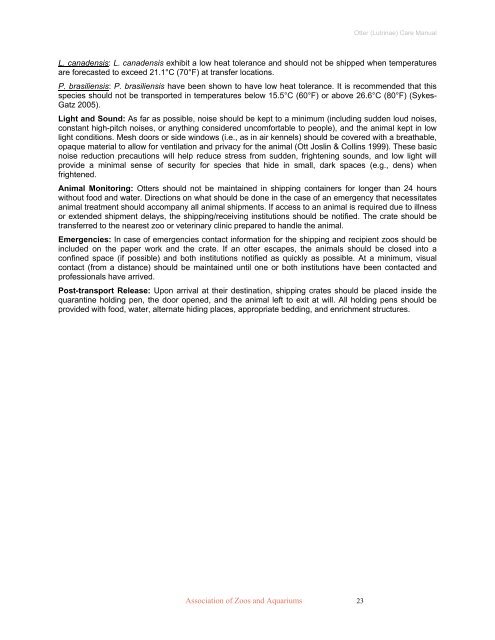Otter (Lutrinae) Care Manual - Association of Zoos and Aquariums
Otter (Lutrinae) Care Manual - Association of Zoos and Aquariums
Otter (Lutrinae) Care Manual - Association of Zoos and Aquariums
You also want an ePaper? Increase the reach of your titles
YUMPU automatically turns print PDFs into web optimized ePapers that Google loves.
<strong>Association</strong> <strong>of</strong> <strong>Zoos</strong> <strong>and</strong> <strong>Aquariums</strong> 23<br />
<strong>Otter</strong> (<strong>Lutrinae</strong>) <strong>Care</strong> <strong>Manual</strong><br />
L. canadensis: L. canadensis exhibit a low heat tolerance <strong>and</strong> should not be shipped when temperatures<br />
are forecasted to exceed 21.1°C (70°F) at transfer locations.<br />
P. brasiliensis: P. brasiliensis have been shown to have low heat tolerance. It is recommended that this<br />
species should not be transported in temperatures below 15.5°C (60°F) or above 26.6°C (80°F) (Sykes-<br />
Gatz 2005).<br />
Light <strong>and</strong> Sound: As far as possible, noise should be kept to a minimum (including sudden loud noises,<br />
constant high-pitch noises, or anything considered uncomfortable to people), <strong>and</strong> the animal kept in low<br />
light conditions. Mesh doors or side windows (i.e., as in air kennels) should be covered with a breathable,<br />
opaque material to allow for ventilation <strong>and</strong> privacy for the animal (Ott Joslin & Collins 1999). These basic<br />
noise reduction precautions will help reduce stress from sudden, frightening sounds, <strong>and</strong> low light will<br />
provide a minimal sense <strong>of</strong> security for species that hide in small, dark spaces (e.g., dens) when<br />
frightened.<br />
Animal Monitoring: <strong>Otter</strong>s should not be maintained in shipping containers for longer than 24 hours<br />
without food <strong>and</strong> water. Directions on what should be done in the case <strong>of</strong> an emergency that necessitates<br />
animal treatment should accompany all animal shipments. If access to an animal is required due to illness<br />
or extended shipment delays, the shipping/receiving institutions should be notified. The crate should be<br />
transferred to the nearest zoo or veterinary clinic prepared to h<strong>and</strong>le the animal.<br />
Emergencies: In case <strong>of</strong> emergencies contact information for the shipping <strong>and</strong> recipient zoos should be<br />
included on the paper work <strong>and</strong> the crate. If an otter escapes, the animals should be closed into a<br />
confined space (if possible) <strong>and</strong> both institutions notified as quickly as possible. At a minimum, visual<br />
contact (from a distance) should be maintained until one or both institutions have been contacted <strong>and</strong><br />
pr<strong>of</strong>essionals have arrived.<br />
Post-transport Release: Upon arrival at their destination, shipping crates should be placed inside the<br />
quarantine holding pen, the door opened, <strong>and</strong> the animal left to exit at will. All holding pens should be<br />
provided with food, water, alternate hiding places, appropriate bedding, <strong>and</strong> enrichment structures.









